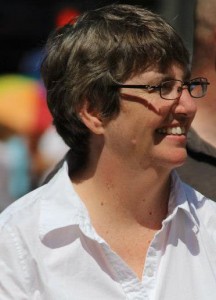Spirit Day is today. Go Purple!
Millions of Americans wear purple on Spirit Day as a sign of support for LGBTQ youth and to speak out against bullying. Spirit Day was started in 2010 by teenager Brittany McMillan as a response to the young people who had taken their own lives. Extraordinary Lutheran Ministries is joining in this Spirit Day and encourages all of our supporters to wear purple, to Change your Facebook photo purple and speak out against bullying.
Rev. Cindy Crane, Proclaim member & 2012 Ministry Grant recipient writes about her anti-bulling work in a special guest blog.
Very recently the ELCA Conference of Bishops voted me back on to the clergy roster after being officially off of the roster for 12 years and on a leave of absence for two years preceding the time I left. Back when I began wandering without a sense of place outside the land of ordained ministry, I never imagined I would return to the roster with a part-time call to do anti-bullying work from a faith perspective. And yet this feels right in many ways. I’m bringing together years of work in a secular organization that dealt with LGBT issues in schools and bullying for any reason with my experience in the church. Thanks to the grant from ELM and its wise requirement that the concept grant I received last year be given to rostered individuals working with a team, I got to create a meaningful ministry with my ordination finally recognized again.

The team I work with includes Travis Currier, Miriam Mueller-Owens, Sierra Mueller-Owens, and Rev. Matthew Kruse. The new middle schooler in our group came up with the name, Lutherans Against Bullying (LAB) for us after the adults anguished for months over a name that would fit us just right theologically. I like the acronym, LAB, because we are a kind of laboratory in the South-Central Synod of Wisconsin.
Targets of bullying can experience their way of seeing life altered. Marueen Duffy and Len Sperry talk about this in their book, Mobbing. Mobbing is bullying by more than one person and involves institutional buy-in. Duffy and Sperry mention that someone mobbed can experience their entire world view change. Targets of mobbing begin to see the people around them through the lens of their mobbing experience. The trauma they had at school, work, church, a condo association, or other place in their community becomes the long-term filter through which they see life. Ruth and Gary Namie at the Workplace Bullying Institute say it’s the long-term effect of trauma that causes counselors to name it as post-traumatic stress disorder (PTSD), and that if you have PTSD from being bullied that would make your workplace, school, etc. a war zone. Duffy and Sperry cite cases of suicide resulting from mobbing; they even call mobbing a contemporary legal means of murder.The whole issue of bullying engages me personally because of the statistics I’ve seen manifested in the faces of young people and individuals of all ages. How we respond to the temptation to abuse power, how we find inner strength when feeling washed over by a bullying situation, and how we choose to respond as witnesses to the bullying of others strike at my faith. And I think of faith as not only being about belief, but also how we see or how we are graced to perceive our relationship with God and our neighbors.
When talking to an adult group recently about bullying I pointed to Marcus Borg’s book, The Heart of Christianity, in which he has a section on faith as seeing. For an exercise I asked people to reflect on challenging experiences they had that brought them closer to God. Then I asked people to think of experiences they thought moved them away from their faith or tempted them to cynicism. What pushed them away? What brought them back? I shared an experience of my own in which I was starting to feel cynicism was defining how I looked at life. It was like grace to recognize that I was seeing people unrelated to a trauma that colored my vision. My eyes opened suddenly and unexpectedly.
Barbara Coloroso in her book, The Bully, the Bullied, and the Bystander, spends time discussing how bullies can influence others to change the way the way they view someone the bully has decided to target. The target gets labeled as someone you can view with contempt and that becomes the standard for how that student is viewed. She cites examples of students switching schools and having totally new experiences in how they are perceived. She also has some great advice for how parents can determine if one of their children is being bullying or is acting as a bully and how to engage with them.
LAB explores reasons for bullying. We spend some time looking at the bully, the target, and how families can get involved. However, we focus mainly on the witnesses of bullying. In many cases we believe it is the culture of a community that makes it possible for bullying to thrive. In a student panel on bullying, led by one of our LAB team members, the youth panelists came up with ways you can be an ally to someone being bullied. It might involve doing something bold within the bullying group or reporting incidents to an adult, or just going up to the person bullied afterwards and letting them know you didn’t like that they were treated poorly. Is the latter too simple? In an atmosphere in which a youth is experiencing contempt or as Rabbi Michael Lerner calls bullying, an act of desanctification, can one person doing something small make a difference. We believe that even a simple gesture that gives the message, I don’t see you in that way, can be powerful.
For an exercise, ask a group of a time that one person made a difference to them.
Bullying is abuse. It can change the way we see ourselves, another person, even life. Actively not joining in campaigns of descanctifying of our neighbor matters to the way we live, to our faith and to others around us. And actively giving the message, I don’t see you that way, to someone bullied makes a difference; by grace it even gives us an opportunity to share our lens of faith and hope.
Cindy Crane was one of the founding volunteers of Extraordinary Candidacy in the Midwest. She lives in the Madison, WI area.

